A Method for the Coefficient Superposition Buckling Bearing Capacity of Thin-Walled Members
Abstract
1. Introduction
2. Experiment and Parameter Design
2.1. Overview of the Experiment
2.2. Material Properties
3. Experimental Results
4. Numerical Simulation
4.1. Finite Element Modeling
4.2. Buckling Analysis
4.3. Static Simulation of Compression
5. Discussion
5.1. Representation of the Missing Mode
5.2. Results of the Simulation
5.3. Extension Form of the Method
- (1)
- n side panels have the same material, dimensions, and boundary conditions;
- (2)
- Only 1 × 1 type of local buckling or non-buckling occurs in each side panel;
- (3)
- At least n of these buckling modes is known and ;
5.4. Finite Element Verification
5.5. Significance of the Method
- (1)
- More intuitive naming rules. Due to the peculiarity of the deformation modes of the structure, the buckling mode vector of the structure can be used as the name of the structure. Compared to the previous classification of the deformation modes of the basic folding elements into asymmetric (Type I) and symmetric (Type II), the present method allows for the further classification of arbitrary deformation modes, as shown in Figure 11. Such naming provides a visual representation of the deformation mode of the structure, and the more sides there are, the more efficiently the information is conveyed. At the same time, the method is richly extensible and equally applicable to higher-order buckling.
- (2)
- Simpler finite element modeling. In general, to simulate the structure, the instrument is used to measure the defects of the structure and the initial displacement value is provided according to the node. This method is expensive and does not apply to large structures. This method only needs to derive the global initial defect through the boundary conditions of the structure and the displacement of the center point of each plate, which makes the modeling process simpler.
- (3)
- More accurate simulation results. By recording the actual buckling characteristics of the structure, this method superimposes the known modes on the basis of the random mode method, which more accurately restores the buckling characteristics of the structure, and the simulation results are more accurate.
6. Conclusions and Outlook
- (1)
- Through the experiments and finite element simulations of the rhombic tube (Figure 4 and Figure 6), there is a non-correspondence between the modes analyzed by finite element buckling and the crushing characteristics of the member, which indicates that the modes analyzed by finite element buckling do not fully satisfy the actual characteristic requirements of the member.
- (2)
- Due to the interaction between the polygonal panels, the buckling orientation of the neighboring side panels affects the buckling modes at the boundaries between the side panels. Still, it has less of an effect on the overall deformation mode of the structure.
- (3)
- Based on the theory of modal superposition, a method of modal correction is proposed in this paper. Based on this method, several modes are corrected by coefficients, and the modal characteristics consistent with the real deformation can be obtained. A deformation mode that matches the actual one can be obtained after superposition using this mode. It also confirms the hypothesis that differences in buckling modes due to boundary conditions have a small effect on the finite element produced results.
- (4)
- After the introduction of the buckling superposition factor, the experimental and simulated values of the rhombic fittings show the same trend and similar results, with the buckling capacity decreasing with the increase in the angle, θ1.
- (5)
- Compared with the traditional modal superposition method, the modal correction coefficients proposed in this paper can make the load-carrying capacity closer to the actual experimental value, and the results are reliable and valid, with strong expandability. With more intuitive naming rules, simpler modeling processes, and more accurate calculation results, this method has important engineering implications.
- (1)
- The sample size of the experiment in this paper is too small, and only one compression experiment is carried out for each working condition. More reproducible samples with different flexion modes are yet to be carried out experimentally.
- (2)
- Some parameters, such as the height-to-width ratio, width-to-thickness ratio, amplitude of initial imperfection, buckling order, etc., need to be further investigated.
Author Contributions
Funding
Data Availability Statement
Conflicts of Interest
References
- Chen, J.; Li, E.; Li, Q.; Hou, S.; Han, X. Crashworthiness and optimization of novel concave thin-walled tubes. Compos. Struct. 2022, 283, 115109. [Google Scholar] [CrossRef]
- Xu, F.; Zhang, X.; Zhang, H. A review on functionally graded structures and materials for energy absorption. Eng. Struct. 2018, 171, 309–325. [Google Scholar] [CrossRef]
- Chen, W.; Wierzbicki, T. Relative merits of single-cell, multi-cell and foam-filled thin-walled structures in energy absorption. Thin-Walled Struct. 2001, 39, 287–306. [Google Scholar] [CrossRef]
- Abramowicz, W.; Wierzbicki, T. Axial Crushing of Multicorner Sheet Metal Columns. J. Appl. Mech. 1989, 56, 113–120. [Google Scholar] [CrossRef]
- Sun, J.; Li, C.; Wu, X.-J.; Palade, V.; Fang, W. An Effective Method of Weld Defect Detection and Classification Based on Machine Vision. IEEE Trans. Ind. Inform. 2019, 15, 6322–6333. [Google Scholar] [CrossRef]
- Gato, C.; Shie, Y.L. Detonation-driven fracture in thin shell structures: Numerical studies. Combust. Explos. Shock Waves 2010, 46, 103–110. [Google Scholar] [CrossRef]
- Brighenti, R. Buckling sensitivity analysis of cracked thin plates under membrane tension or compression loading. Nucl. Eng. Des. 2009, 239, 965–980. [Google Scholar] [CrossRef]
- Aoki, T.; Migita, Y.; Fukumoto, Y. Local buckling strength of closed polygon folded section columns. J. Constr. Steel Res. 1991, 20, 259–270. [Google Scholar] [CrossRef]
- Falkowicz, K. Stability and Failure of Thin-Walled Composite Plate Elements with Asymmetric Configurations. Materials 2024, 17, 1943. [Google Scholar] [CrossRef]
- Chen, Y.; Shi, J.; Lu, C.; Feng, J.; Sareh, P. Hierarchical Clustering-Based Collapse Mode Identification and Design Optimization of Energy-Dissipation Braces Inspired by the Triangular Resch Pattern. J. Struct. Eng. 2024, 150, 04024037. [Google Scholar] [CrossRef]
- Mahdy, W.M.; Wang, L.; Liu, F.; Zhao, L. The competition between buckling and stress failure of degraded composite cylindrical shell under combined axial compression and external pressure loads. Thin-Walled Struct. 2024, 199, 111731. [Google Scholar] [CrossRef]
- He, Z.; Peng, S.; Zhou, X.; Li, Z.; Yang, G.; Zhang, Z. Design recommendation of cold-formed steel built-up sections under concentric and eccentric compression. J. Constr. Steel Res. 2024, 212, 108255. [Google Scholar] [CrossRef]
- Zhang, Z.; Liu, Q.; Fu, J.; Lu, Y. Parametric study on the crashworthiness of the Al/CFRP/GFRP hybrid tubes under quasi-static crushing. Thin-Walled Struct. 2023, 192, 111156. [Google Scholar] [CrossRef]
- Ismail, M.S.; Ifayefunmi, O.; Mazli, A.H. Combined stability of cone-cylinder transition subjected to axial compression and external pressure. Thin-Walled Struct. 2020, 157, 107102. [Google Scholar] [CrossRef]
- Zhu, B.L.; Guo, Y.L.; Zhou, P.; Zhang, Y.H. Load resistance and hysteretic response of rhombic grid hyperboloid-latticed shell subjected to combined vertical and horizontal loads. Struct. Des. Tall Spec. Build. 2018, 27, e1481. [Google Scholar] [CrossRef]
- See, T.; McConnel, R.E. Large Displacement Elastic Buckling of Space Structures. J. Struct. Eng. 1986, 112, 1052–1069. [Google Scholar] [CrossRef]
- Riazi, E.; Yazdani, M.; Afrazi, M. Numerical Study of Slip Distribution at Pre-existing Crack in Rock Mass using Extended Finite Element Method (XFEM). Iran. J. Sci. Technol.-Trans. Civ. Eng. 2023, 47, 2349–2363. [Google Scholar] [CrossRef]
- Wang, Z.; Zeng, Z.; Song, Y.; Li, X. Finite Element Simulation of Ultrasonic Scattering by Rough Flaws with Multi-Scale Distortions. Materials 2022, 15, 8633. [Google Scholar] [CrossRef]
- Euser, B.; Rougier, E.; Lei, Z.; Knight, E.E.; Frash, L.P.; Carey, J.W.; Viswanathan, H.; Munjiza, A. Simulation of Fracture Coalescence in Granite via the Combined Finite-Discrete Element Method. Rock Mech. Rock Eng. 2019, 52, 3213–3227. [Google Scholar] [CrossRef]
- Suga, K.; Kikuchi, M.; Wada, Y.; Kawai, H. Study on fatigue growth of multi-surface flaws in shaft under rotary bending by S-FEM. Eng. Fract. Mech. 2017, 174, 207–214. [Google Scholar] [CrossRef]
- Hertele, S.; De Waele, W.; Denys, R.; Verstraete, M.; Van Wittenberghe, J. Parametric finite element model for large scale tension tests on flawed pipeline girth welds. Adv. Eng. Softw. 2012, 47, 24–34. [Google Scholar] [CrossRef]
- Chen, X.; Shen, S.Z. Complete Load-Deflection Response and Initial Imperfection Analysis of Single-Layer Lattice Dome. Int. J. Space Struct. 1993, 8, 271–278. [Google Scholar] [CrossRef]
- Zhang, X.; Zhang, H. Experimental and numerical investigation on crush resistance of polygonal columns and angle elements. Thin-Walled Struct. 2012, 57, 25–36. [Google Scholar] [CrossRef]
- Zhang, X.; Huh, H. Crushing analysis of polygonal columns and angle elements. Int. J. Impact Eng. 2010, 37, 441–451. [Google Scholar] [CrossRef]
- Tong, Z.; Zheng, F.; Xie, M. Simulation analysis of buckling of defective cylindrical shell (in Chinese). J. Harbin Inst. Technol. 2022, 54, 64–69. [Google Scholar]
- Shiomitsu, D.; Yanagihara, D. Elastic local shell and stiffener-tripping buckling strength of ring-stiffened cylindrical shells under external pressure. Thin-Walled Struct. 2020, 148, 106622. [Google Scholar] [CrossRef]
- Abdulhameed, O.; Al-Ahmari, A.; Ameen, W.; Mian, S.H. Additive manufacturing: Challenges, trends, and applications. Adv. Mech. Eng. 2019, 11, 1687814018822880. [Google Scholar] [CrossRef]
- ASTM E8/E8M-24; Standard Test Methods for Tension Testing of Metallic Materials. ASMT: New York, NY, USA, 2024.
- Sun, M.; Wang, L.; Lu, H.; Xiong, Z.; Xie, M.; Xu, B. The Numerical Study on the Blast Resistance Performance of Protection Armor with I-Core Sandwich. Iran. J. Sci. Technol. Trans. Civ. Eng. 2024, 48, 895–908. [Google Scholar] [CrossRef]
- Martins, A.D.; Gonçalves, R.; Camotim, D. On the local and distortional post-buckling behaviour of thin-walled regular polygonal tubular columns. Thin-Walled Struct. 2019, 138, 46–63. [Google Scholar] [CrossRef]
- Xu, B.; Wang, L.; Xiang, C.; Han, Z. Analysis of Buckling Deformation for the Side Plate of Rectangular CSFT Column Based on Plate Theory with Bi-Axial Loads. Buildings 2022, 12, 626. [Google Scholar] [CrossRef]
- Xu, B.; Wang, L.; Chen, Y.; Gu, J.; Fu, M.; Zhang, D. Study on Axial Load Mechanical Behavior of Square Concrete-Filled Tubular Steel Stub Column with Gap. Iran. J. Sci. Technol. Trans. Civ. Eng. 2023, 47, 741–751. [Google Scholar] [CrossRef]
- Xu, B.; Wang, L.; Xie, M.-Z. Research on a Buckling Detection Technique for Rectangular Concrete-filled Steel Tubular Columns based on Grating Projection. J. Comput. 2022, 33, 1–10. [Google Scholar]
- Jiang, B.; Chen, Z.; Yin, Z.; Xiao, L. Buckling and critical temperatures of restrained H-section steel columns in fire considering dynamic effect. Fire Saf. J. 2023, 141, 104006. [Google Scholar] [CrossRef]
- Liu, T.; Wang, P.; Wen, W. An improved time-marching formulation based on an explicit time integration method for dynamic analysis of non-viscous damping systems. Mech. Syst. Signal Process. 2023, 191, 110195. [Google Scholar] [CrossRef]
- Wang, M.; Zhang, K.; Chen, C.; Liu, W. An explicit dynamic FFT method for homogenizing heterogeneous solids under large deformations. Int. J. Eng. Sci. 2023, 192, 103930. [Google Scholar] [CrossRef]
- Whitmore, D.; Aguilar-Vidal, V.; Miletić, M.; Bianchini, A.; Davidson, J.S. Airfield pavement resiliency assessment against extreme dynamic events by explicit axisymmetric finite element models. Transp. Geotech. 2023, 43, 101144. [Google Scholar] [CrossRef]
- Xie, S.; Kolay, C.; Feng, D.-C.; Ricles, J.M. Nonlinear static analysis of extreme structural behavior: Overcoming convergence issues via an unconditionally stable explicit dynamic approach. Structures 2023, 49, 58–69. [Google Scholar] [CrossRef]
- Gao, Q.; Liao, W. Energy absorption of thin walled tube filled with gradient auxetic structures-theory and simulation. Int. J. Mech. Sci. 2021, 201, 106475. [Google Scholar] [CrossRef]
- San Ha, N.; Pham, T.M.; Chen, W.; Hao, H.; Lu, G. Crashworthiness analysis of bio-inspired fractal tree-like multi-cell circular tubes under axial crushing. Thin-Walled Struct. 2021, 169, 108315. [Google Scholar]
- Hu, D.; Wang, Y.; Song, B.; Dang, L.; Zhang, Z. Energy-absorption characteristics of a bionic honeycomb tubular nested structure inspired by bamboo under axial crushing. Compos. Part B-Eng. 2019, 162, 21–32. [Google Scholar] [CrossRef]
- Ha, N.S.; Lu, G.; Xiang, X. Energy absorption of a bio-inspired honeycomb sandwich panel. J. Mater. Sci. 2019, 54, 6286–6300. [Google Scholar] [CrossRef]
- Zhao, X.; Zhu, G.; Zhou, C.; Yu, Q. Crashworthiness analysis and design of composite tapered tubes under multiple load cases. Compos. Struct. 2019, 222, 110920. [Google Scholar] [CrossRef]
- Zhuang, Z. The Finite Element Software ABAQUS/Explicit Start Guide; Tsinghua University Press: Beijing, China, 2004. [Google Scholar]
- Yao, R.; Yin, G.-S.; Hao, W.-Q.; Zhao, Z.-Y.; Li, X.; Qin, X.-L. Axial buckling modes and crashworthiness of circular tube with external linear gradient grooves. Thin-Walled Struct. 2019, 134, 395–406. [Google Scholar] [CrossRef]
- Alavi Nia, A.; Haddad Hamedani, J. Comparative analysis of energy absorption and deformations of thin walled tubes with various section geometries. Thin-Walled Struct. 2010, 48, 946–954. [Google Scholar] [CrossRef]
- Fan, Z.; Lu, G.; Liu, K. Quasi-static axial compression of thin-walled tubes with different cross-sectional shapes. Eng. Struct. 2013, 55, 80–89. [Google Scholar] [CrossRef]
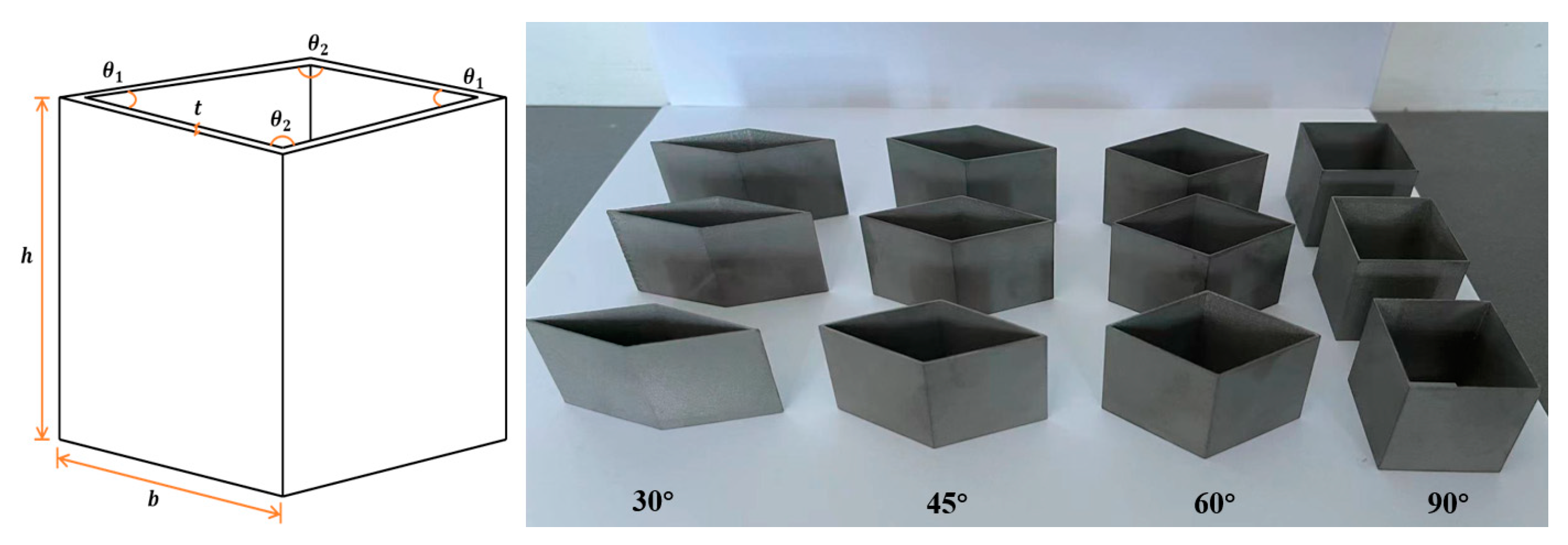
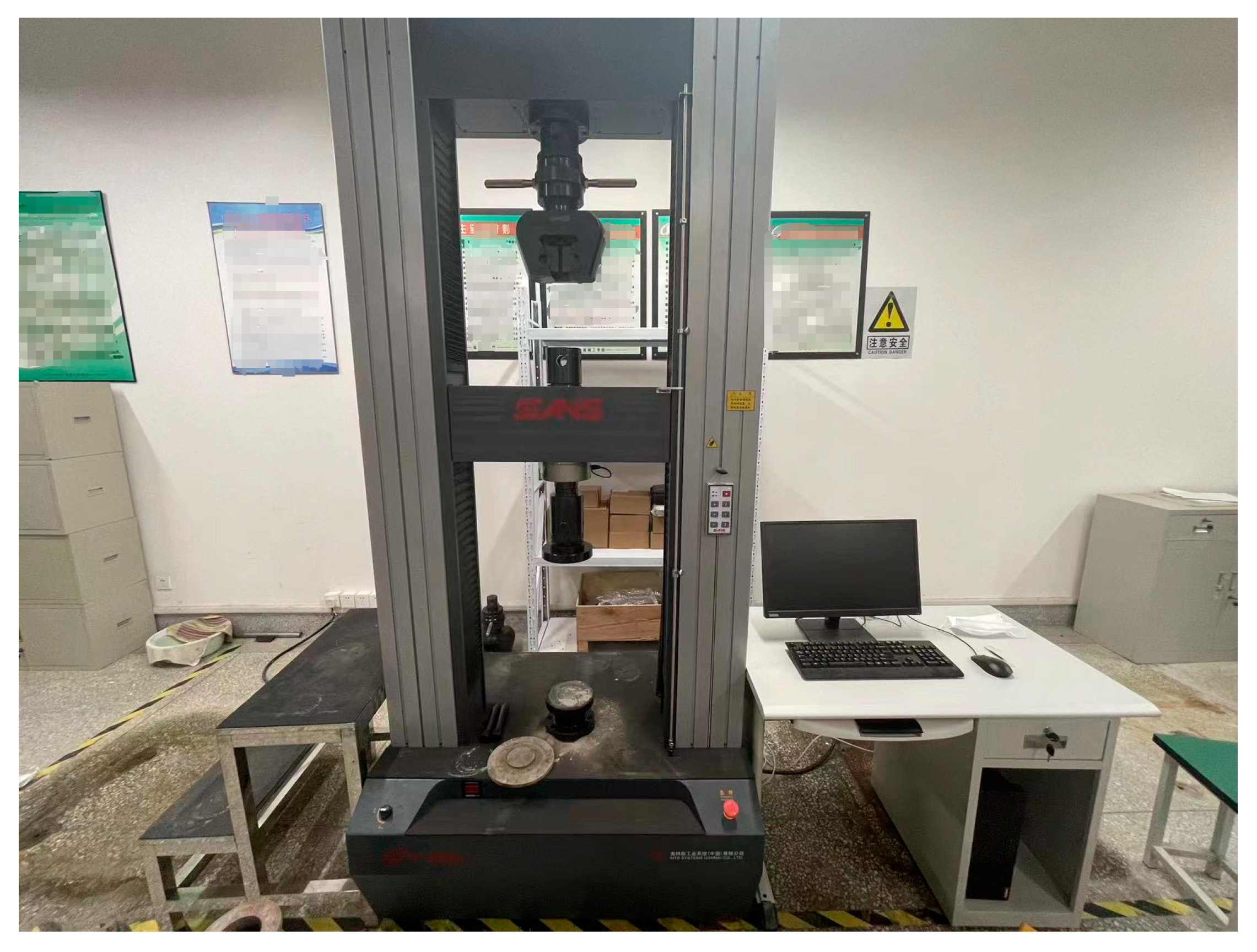
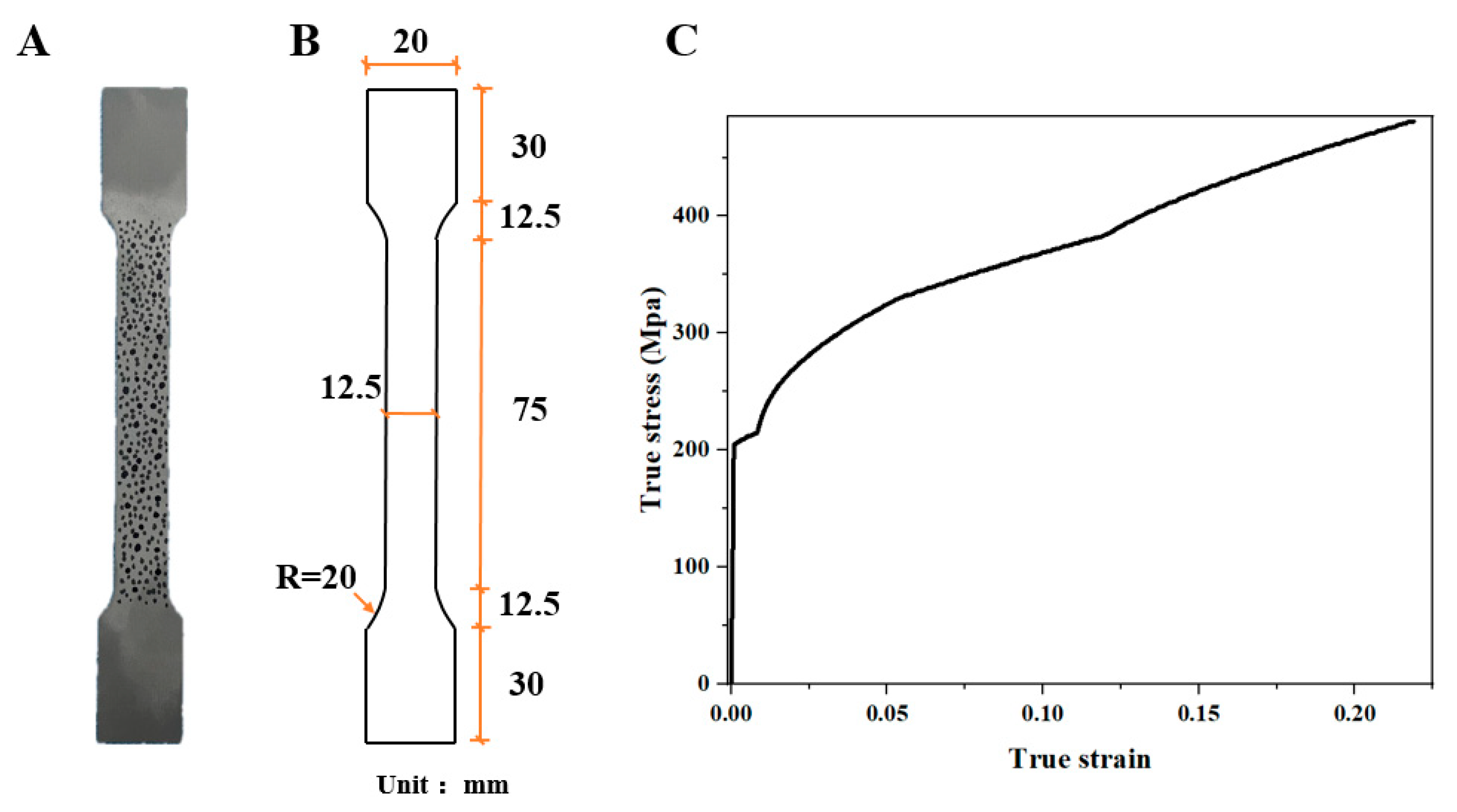

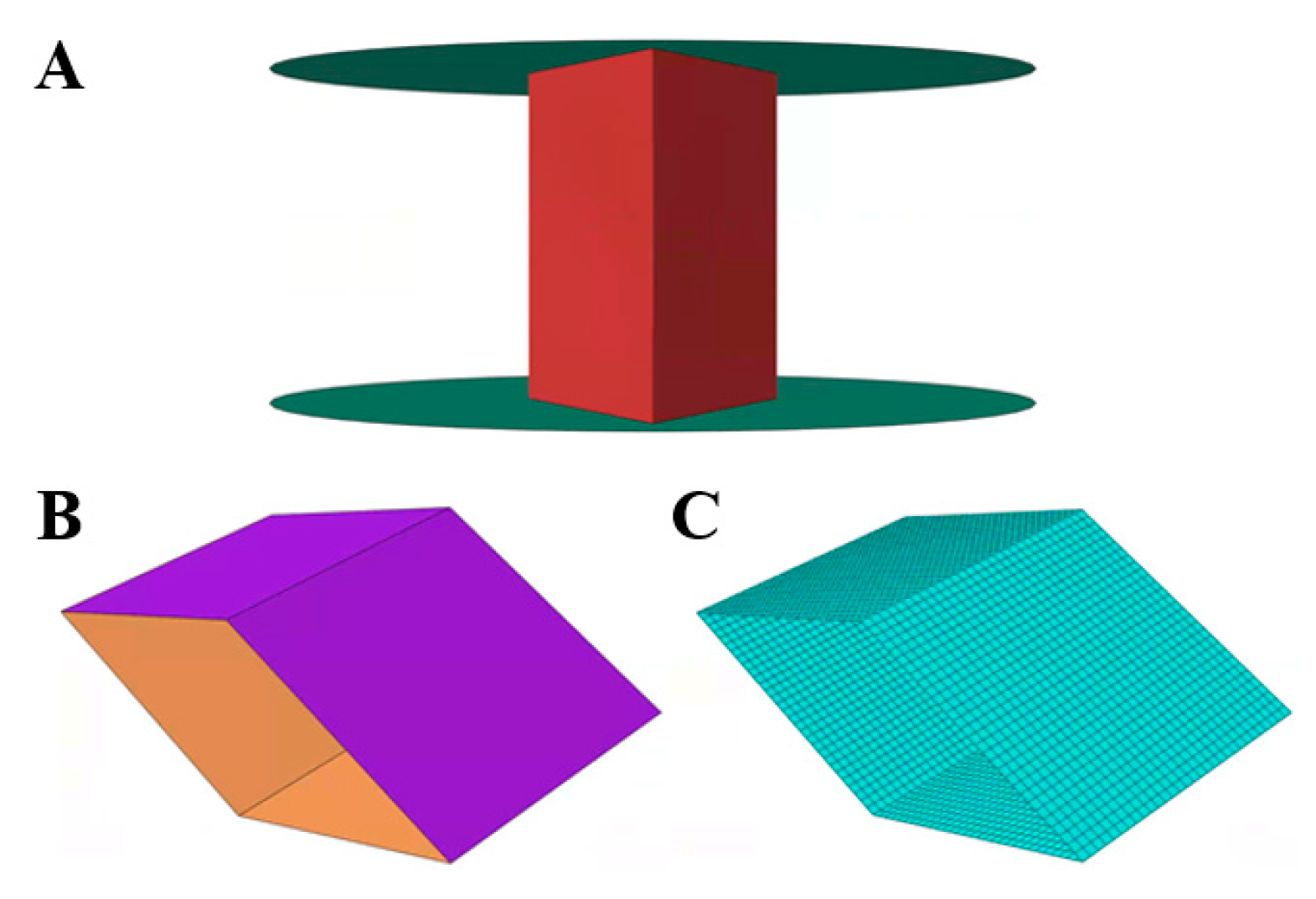
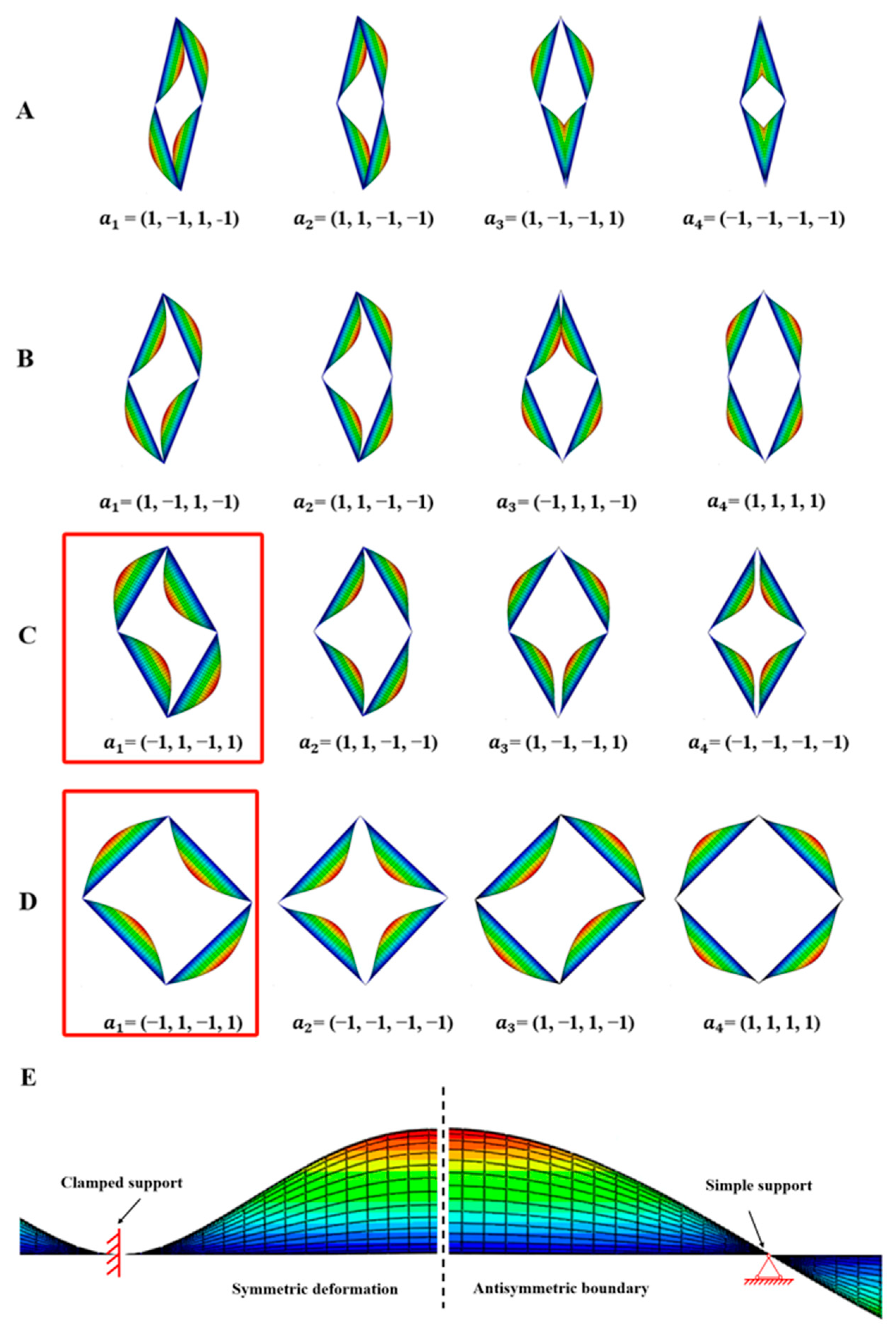
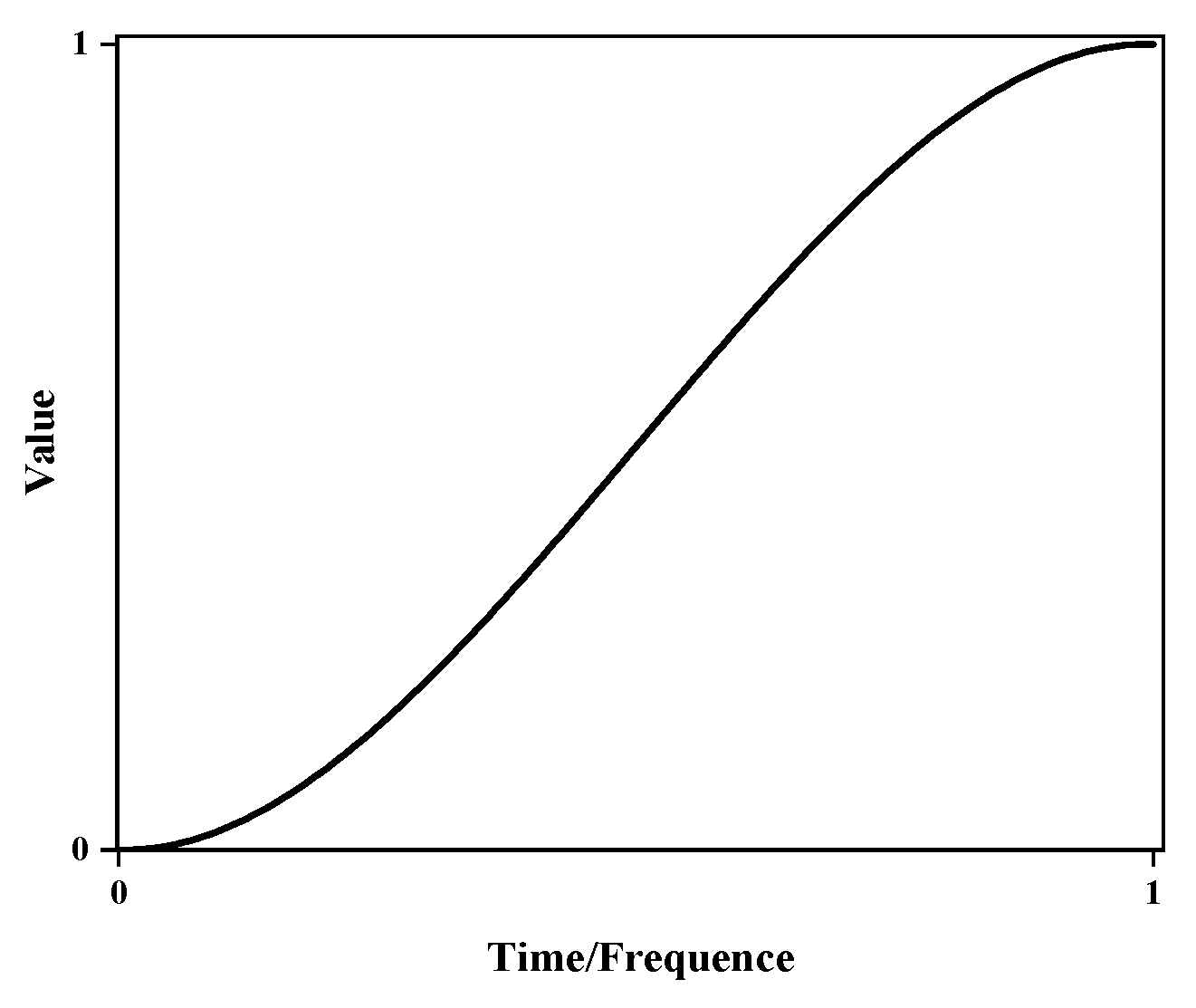
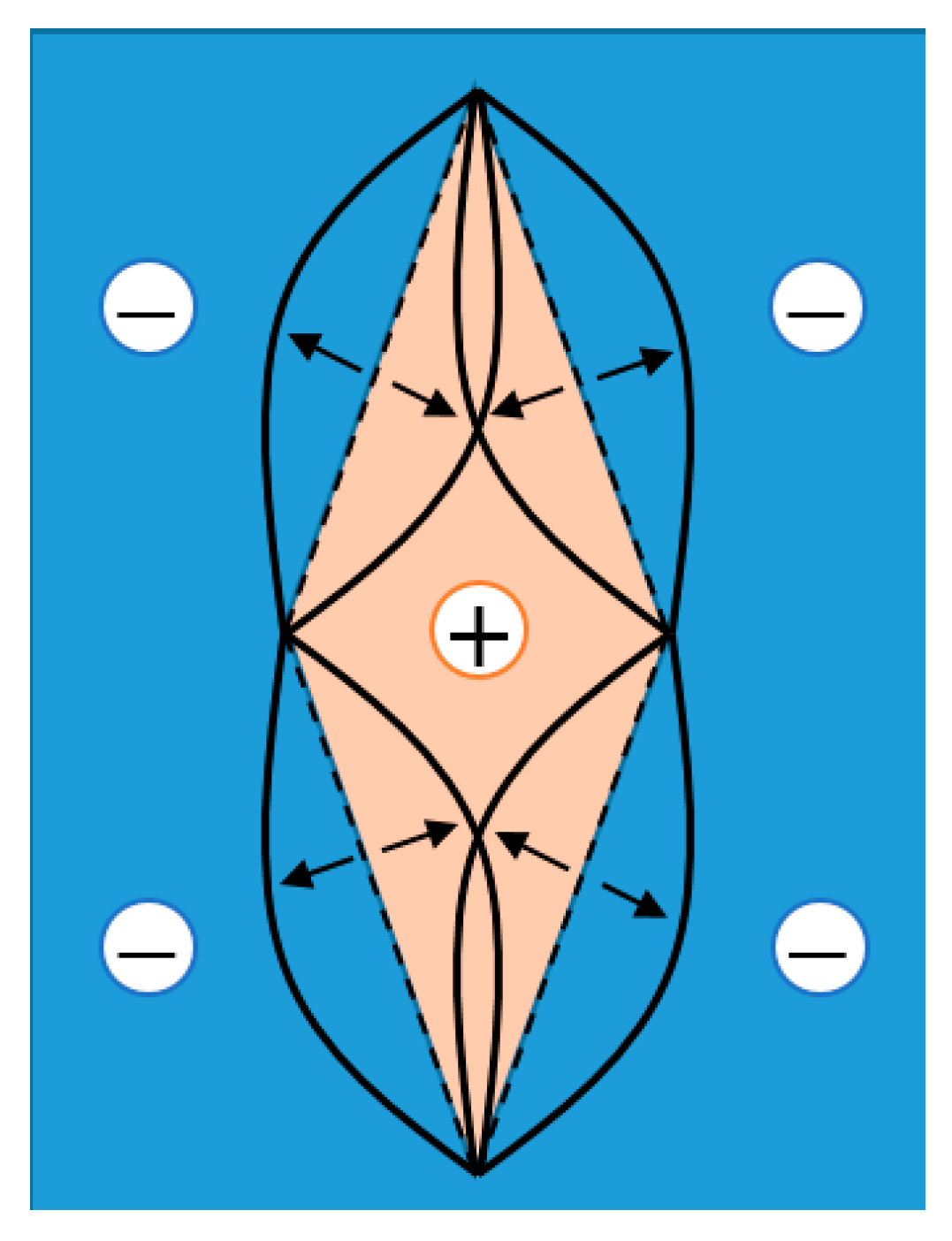
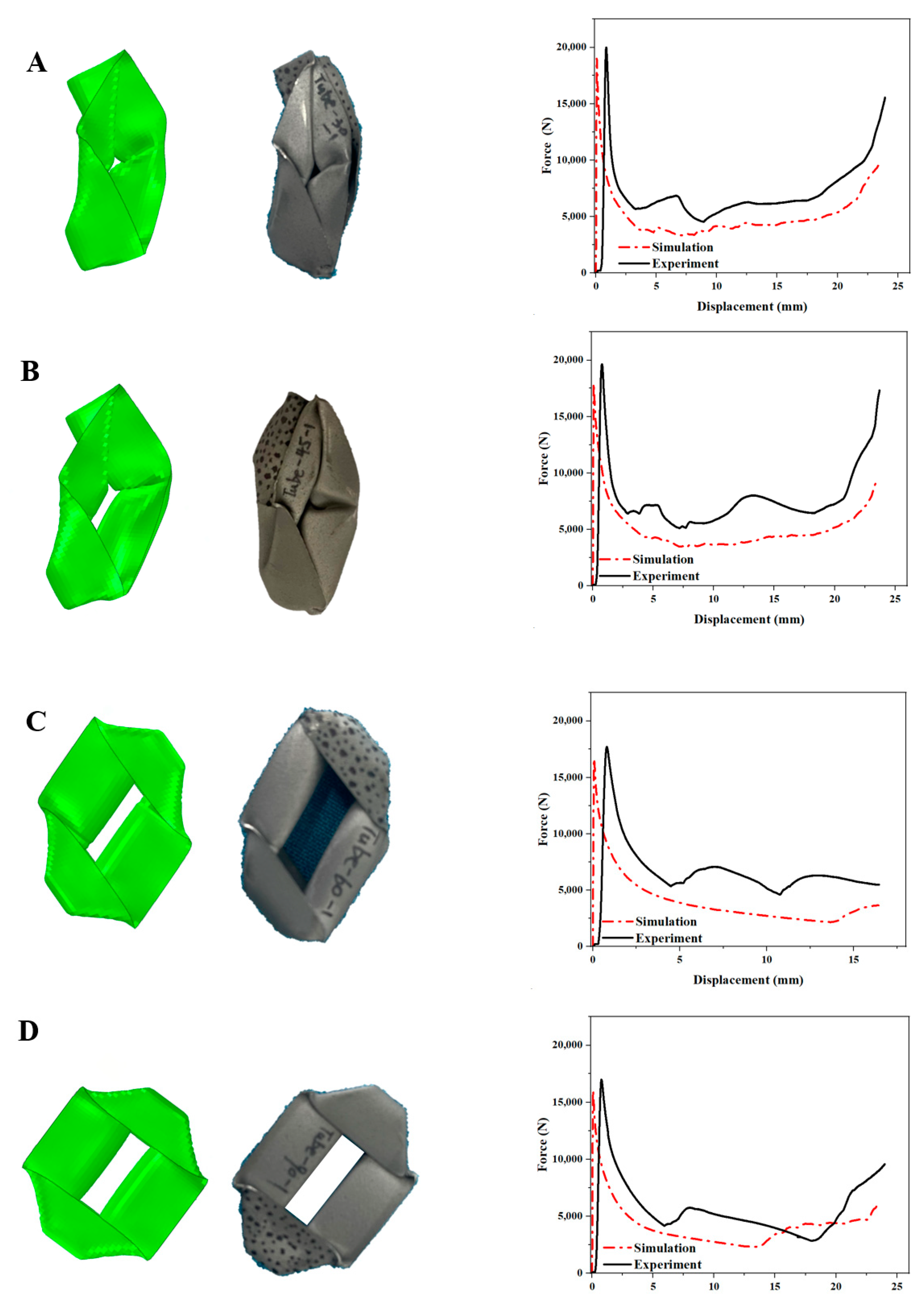
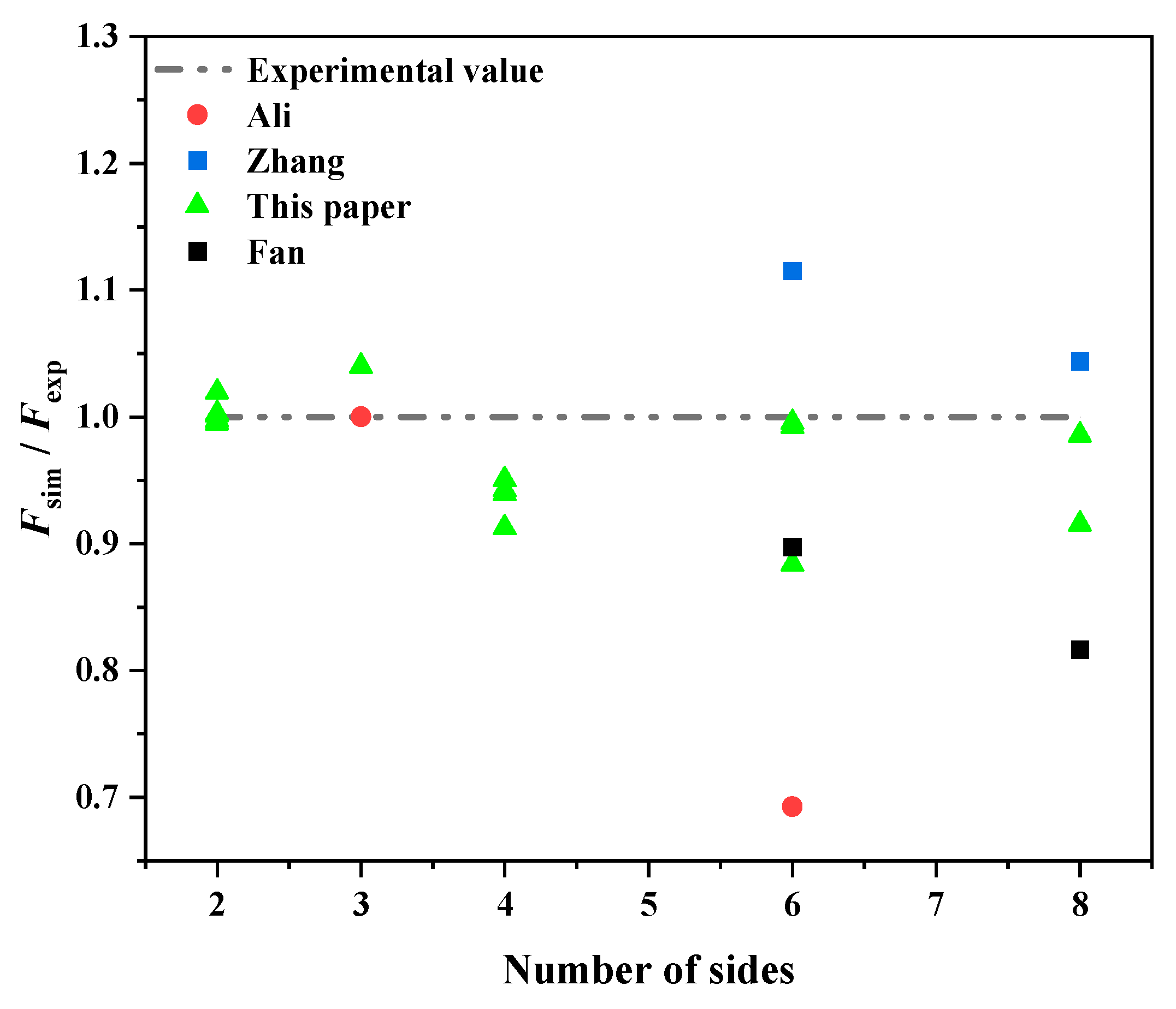
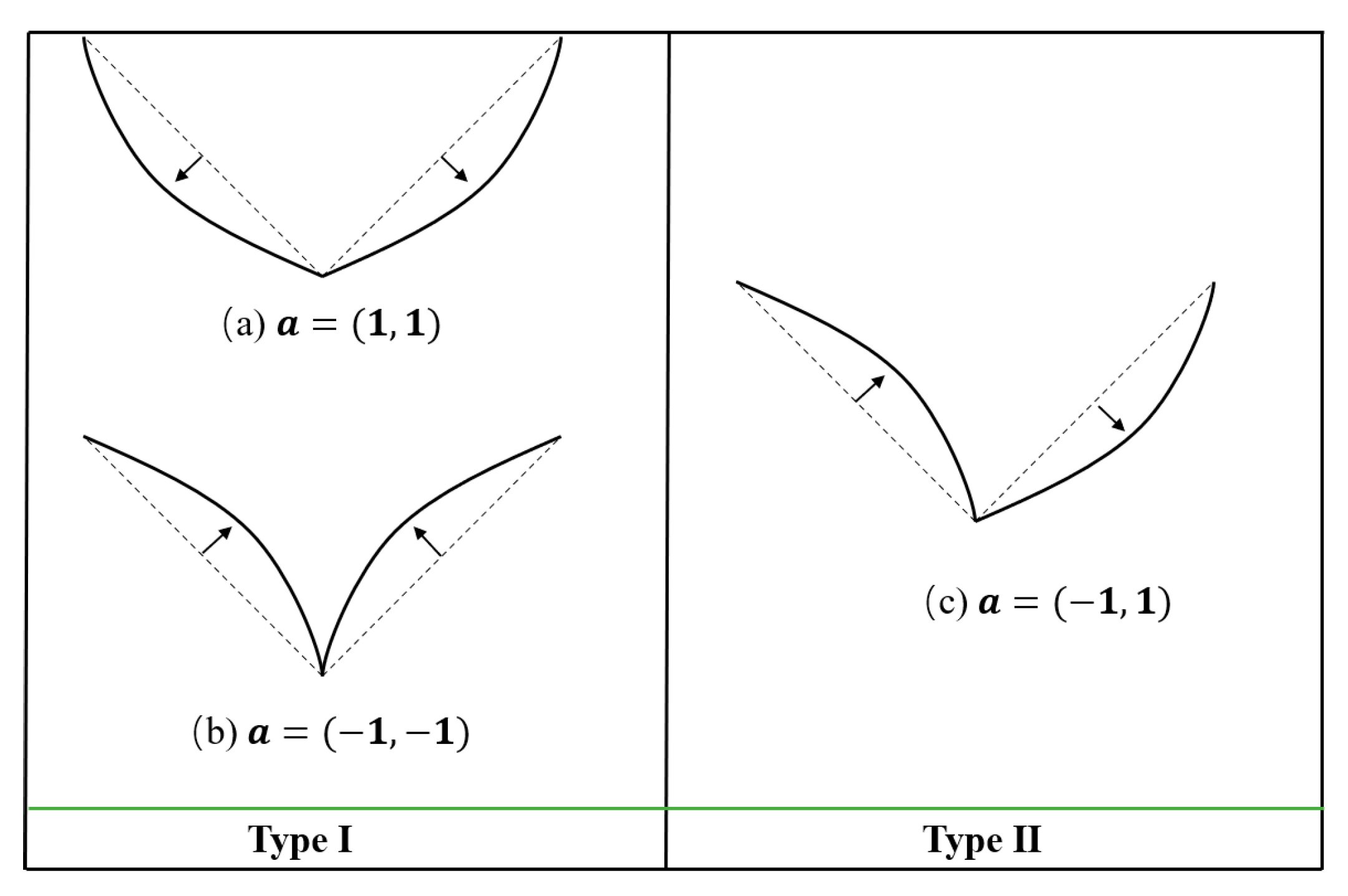
| 30 | 0.6 | (1, −1, 1, −1) | (−1, −1, 1, −1) | 0.3 | −0.3 | −0.3 | 0.3 |
| (1, 1, −1, −1) | |||||||
| (1, −1, −1, 1) | |||||||
| (−1, −1, −1, −1) | |||||||
| 45 | (1, −1, 1, −1) | (1, −1, −1, −1) | 0 | 0.6 | −0.6 | −0.6 | |
| (1, 1, −1, −1) | |||||||
| (−1, 1, 1, −1) | |||||||
| (1, 1, 1, 1) | |||||||
| 60 | (−1, 1, −1, 1) | (1, −1, 1, −1) | 0.6 | 0 | 0 | 0 | |
| (−1, −1, −1, −1) | |||||||
| (1, 1, −1, −1) | |||||||
| (1, −1, −1, 1) | |||||||
| 90 | (−1, 1, −1, 1) | (1, −1, 1, −1) | 0.6 | 0 | 0 | 0 | |
| (−1, −1, −1, −1) | |||||||
| (1, −1, 1, −1) | |||||||
| (1, 1, 1, 1) |
| Serial Number | (°) | (mm) | (mm) | (mm) | Initial Peak Crushing Force (KN) | |||
|---|---|---|---|---|---|---|---|---|
| Experiment | Simulation | |||||||
| Tube30 | 30 | (−1, −1, 1, −1) | 30 | 30 | 0.6 | 0.6 | 19.990 | 19.005 |
| Tube45 | 45 | (1, −1, −1, −1) | 19.644 | 17.933 | ||||
| Tube60 | 60 | (1, −1, 1, −1) | 17.711 | 16.642 | ||||
| Tube90 | 90 | (1, −1, 1, −1) | 16.993 | 16.018 | ||||
| Author | Shape | Material | Parameters of a Side Panel | Initial Peak Crushing Force | ||||
|---|---|---|---|---|---|---|---|---|
| Width (mm) | Height (mm) | Thickness (mm) | (KN) | (KN) | (KN) | |||
| Alavi Nia [46] | Triangle | Aluminum alloy | 62.8 | 100 | 1.5 | 31.346 | 31.350 | 32.605 |
| Alavi Nia [46] | Hexagon | Aluminum alloy | 31.4 | 100 | 1.5 | 36.875 | 25.540 | 31.441 |
| Zhang [23] | Hexagon | Mid-steel Q235 | 40 | 180 | 1.2 | 59.021 | 65.825 | 58.590 |
| Zhang [23] | Octagon | Mid-steel Q235 | 40 | 180 | 1.2 | 82.446 | 86.087 | 81.305 |
| Fan [47] | Hexagon | Mid-steel | 33.2 | 100 | 1.5 | 95.7 | 85.9 | 95.303 |
| Fan [47] | Octagon | Mid-steel | 24.9 | 100 | 1.5 | 110.2 | 90 | 100.896 |
Disclaimer/Publisher’s Note: The statements, opinions and data contained in all publications are solely those of the individual author(s) and contributor(s) and not of MDPI and/or the editor(s). MDPI and/or the editor(s) disclaim responsibility for any injury to people or property resulting from any ideas, methods, instructions or products referred to in the content. |
© 2024 by the authors. Licensee MDPI, Basel, Switzerland. This article is an open access article distributed under the terms and conditions of the Creative Commons Attribution (CC BY) license (https://creativecommons.org/licenses/by/4.0/).
Share and Cite
Xu, B.; Wang, L.; Liu, Q.; Wang, R.; Kong, B.; Xu, B. A Method for the Coefficient Superposition Buckling Bearing Capacity of Thin-Walled Members. Buildings 2024, 14, 3236. https://doi.org/10.3390/buildings14103236
Xu B, Wang L, Liu Q, Wang R, Kong B, Xu B. A Method for the Coefficient Superposition Buckling Bearing Capacity of Thin-Walled Members. Buildings. 2024; 14(10):3236. https://doi.org/10.3390/buildings14103236
Chicago/Turabian StyleXu, Bing, Lang Wang, Qin Liu, Rui Wang, Bing Kong, and Bo Xu. 2024. "A Method for the Coefficient Superposition Buckling Bearing Capacity of Thin-Walled Members" Buildings 14, no. 10: 3236. https://doi.org/10.3390/buildings14103236
APA StyleXu, B., Wang, L., Liu, Q., Wang, R., Kong, B., & Xu, B. (2024). A Method for the Coefficient Superposition Buckling Bearing Capacity of Thin-Walled Members. Buildings, 14(10), 3236. https://doi.org/10.3390/buildings14103236







